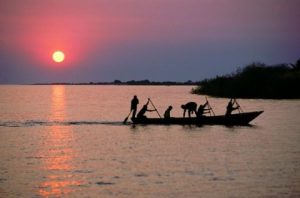
Lake Mweru (also spelled Mwelu) is a freshwater lake on the longest arm of Africa’s second-longest river, the Congo. Located on the border between Zambia and Democratic Republic of the Congo, it makes up 110 km of the total length of the Congo, lying between its Luapula River (upstream) and Luvua River (downstream) segments.
Mweru means ‘lake’ in a number of Bantu languages, so it is often referred to as just ‘Mweru
Mweru is mainly fed by the Luapula River, which comes in through swamps from the south, and the Kalungwishi River from the east.
At its north end the lake is drained by the Luvua River, which flows in a northwesterly direction to join the Lualaba River and thence to the Congo.
It is the second-largest lake in the Congo’s drainage basin and is located 150 km west of the southern end of the largest, Lake Tanganyika.
The Luapula forms a swampy delta almost as wide as the southern end of the lake. In a number of respects the lower river and lake can be treated as one entity.
For a lake in a region with pronounced wet and dry seasons, Mweru does not change much in level and area. The annual fluctuation in level is 1.7m, with seasonal highs in May and lows in January.
This is partly because the Luapula drains out of the Bangweulu Swamps and floodplain which tend to regulate the water flow, absorbing the annual flood and releasing it slowly, and partly because Mweru’s outlet, the Luvua, drops quickly and flows swiftly, without vegetation to block it.
A rise in Mweru is quickly offset by a faster flow down the Luvua.
Mweru’s average length is 118 km and its average width is 45 km, with its long axis oriented northeast-southwest.
Its elevation is 917 m, quite a bit higher than Tanganyika (763 m).It is a rift valley lake lying in the Lake Mweru-Luapula graben, which is a branch of the Great Rift Valley.
The western shore of the lake in DR Congo exhibits the steep escarpment typical of a rift valley lake, rising to the Kundelungu Mountains beyond, but the rift valley escarpment is less pronounced on the eastern shore.
Mweru is shallow in the south and deeper in the north, with two depressions in the north-eastern section with maximum depths of 20 m and 27 m.
A smaller very marshy lake called Mweru Wantipa (also known as the Mweru Marshes) lies about 50 km to its east, and north of the Kalungwishi.
It is mostly endorheic and actually takes water from the Kalungwishi through a dambo most of the time, but in times of high flood it may overflow into the Kalungwishi and Lake Mweru


